Discover 11 hidden attractions, cool sights, and unusual things to do in Saqqara (Egypt). Don't miss out on these must-see attractions: Pyramid of Djoser, Pyramid of Unas, and Pyramid of Nyuserre. Also, be sure to include Imhotep Museum in your itinerary.
Below, you can find the list of the most amazing places you should visit in Saqqara (Al Jizah).
Table of Contents
Pyramid of Djoser

Also known as: هرم زوسر
Ruins of step pyramid built for pharaoh. The Pyramid of Djoser, or Step Pyramid, is an archaeological site in the Saqqara necropolis, Egypt, northwest of the city of Memphis. The 6-tier, 4-sided structure is the earliest colossal stone building in Egypt. It was built in the 27th century BC during the Third Dynasty for the burial of Pharaoh Djoser. The pyramid is the central feature of a vast mortuary complex in an enormous courtyard surrounded by ceremonial structures and decoration. Its architect was Imhotep, chancellor of the pharaoh and high priest of the god Ra.
The pyramid went through several revisions and redevelopments of the original plan. The pyramid originally stood 62.5 m (205 ft) tall, with a base of 109 m × 121 m (358 ft × 397 ft) and was clad in polished white limestone. The step pyramid (or proto-pyramid) was considered to be the earliest large-scale cut stone construction made by man as of 1997, although the nearby enclosure wall "Gisr el-Mudir" is suggested by some Egyptologists to predate the complex, and the South American pyramids at Caral are contemporary.
In March 2020, the pyramid was reopened for visitors after a 14-year restoration.[1]
Pyramid of Unas
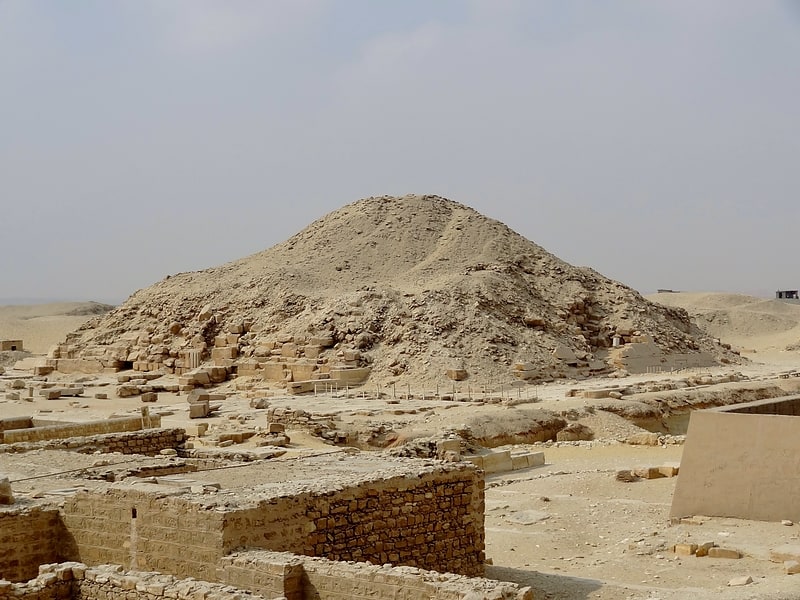
Also known as: هرم أوناس
The Pyramid of Unas is a smooth-sided pyramid built in the 24th century BC for the Egyptian pharaoh Unas, the ninth and final king of the Fifth Dynasty. It is the smallest Old Kingdom pyramid, but significant due to the discovery of Pyramid Texts, spells for the king's afterlife incised into the walls of its subterranean chambers. Inscribed for the first time in Unas's pyramid, the tradition of funerary texts carried on in the pyramids of subsequent rulers, through to the end of the Old Kingdom, and into the Middle Kingdom through the Coffin Texts that form the basis of the Book of the Dead.
Unas built his pyramid between the complexes of Sekhemket and Djoser, in North Saqqara. Anchored to the valley temple at a nearby lake, a long causeway was constructed to provide access to the pyramid site. The causeway had elaborately decorated walls covered with a roof which had a slit in one section allowing light to enter, illuminating the images. A long wadi was used as a pathway. The terrain was difficult to negotiate and contained old buildings and tomb superstructures. These were torn down and repurposed as underlay for the causeway. A significant stretch of Djoser's causeway was reused for embankments. Tombs that were on the path had their superstructures demolished and were paved over, preserving their decorations. Two Second Dynasty tombs, presumed to belong to Hotepsekhemwy, Nebra, and Ninetjer, from seals found inside, are among those that lie under the causeway. The site was later used for numerous burials of Fifth Dynasty officials, private individuals from the Eighteenth to Twentieth Dynasties, and a collection of Late Period monuments known as the "Persian tombs".
The causeway joined the temple in the harbour with the mortuary temple on the east face of the pyramid. The mortuary temple was entered on its east side through a large granite doorway, seemingly constructed by Unas's successor, Teti. Just south of the upper causeway are two long boat pits. These may have contained two wooden boats: the solar barques of Ra, the sun god. The temple was laid out in a similar manner to Djedkare Isesi's. A transverse corridor separates the outer from the inner temple. The entry chapel of the inner temple has been completely destroyed, though it once contained five statues in niches. A feature of the inner temple was a single quartzite column that was contained in the antichambre carrée. The room is otherwise ruined. Quartzite is an atypical material to use in architectural projects, though examples of it being used sparingly in the Old Kingdom exist. The material is associated with the sun cult due to its sun-like coloration.
The underground chambers remained unexplored until 1881, when Gaston Maspero, who had recently discovered inscribed texts in the pyramids of Pepi I and Merenre I, gained entry. Maspero found the same texts inscribed on the walls of Unas's pyramid, their first known appearance. The 283 spells in Unas's pyramid constitute the oldest, smallest and best preserved corpus of religious writing from the Old Kingdom. Their function was to guide the ruler through to eternal life and ensure his continued survival even if the funerary cult ceased to function. In Unas's case, the funerary cult may have survived the turbulent First Intermediate Period and up until the Twelfth or Thirteenth Dynasty, during the Middle Kingdom. This is a matter of dispute amongst Egyptologists, where a competing idea is that the cult was revived during the Middle Kingdom, rather than having survived until then.[2]
Address: South of the Step Pyramid, 11511 Cairo
Pyramid of Nyuserre

Ruin in Egypt. The Pyramid of Nyuserre is a mid-25th-century BC pyramid complex built for the Egyptian pharaoh Nyuserre Ini of the Fifth Dynasty. During his reign, Nyuserre had the unfinished monuments of his father, Neferirkare Kakai, mother, Khentkaus II, and brother, Neferefre, completed, before commencing work on his personal pyramid complex. He chose a site in the Abusir necropolis between the complexes of Neferirkare and Sahure, which, restrictive in area and terrain, economized the costs of labour and material. Nyuserre was the last king to be entombed in the necropolis; his successors chose to be buried elsewhere. His monument encompasses a main pyramid, a mortuary temple, a valley temple on Abusir Lake, a causeway originally intended for Neferirkare's monument, and a cult pyramid.
The main pyramid had a stepped core built from rough-cut limestone and encased in fine Tura limestone. The casing was stripped down by stone thieves, leaving the core exposed to the elements and further human activity, which have reduced the once nearly 52 m (171 ft; 99 cu) tall pyramid to a mound of ruins, with a substructure that is dangerous to enter due to the risk of cave-ins. Adjoining the pyramid's east face is the mortuary temple with its unusual configuration and features. Replacing the usual T-shape plan, the mortuary temple has an L-shape; an alteration required due to the presence of mastabas to the east. It debuted the antichambre carrée, a square room with a single column, which became a standard feature of later monuments. It also contains an unexplained square platform which has led archaeologists to suggest that there may be a nearby obelisk pyramidion. This is unusual as obelisks were central features of Egyptian sun temples, but not of pyramid complexes. Finally, the north-east and south-east corners of the site have two structures which appear to have been pylon prototypes. These became staple features of temples and palaces. In the south-east corner of the complex, a separate enclosure hosts the cult pyramid – a small pyramid whose purpose remains unclear. A long causeway binds the mortuary and valley temples. These two were under construction for Neferirkare's monument, but were repurposed for that of Nyuserre. The causeway, which had been more than half completed when Neferirkare died, thus has a bend where it changes direction from Neferirkare's mortuary temple towards Nyuserre's.
Two other pyramid complexes have been found in the area. Known as Lepsius XXIV and Lepsius XXV, they may have belonged to the consorts of Nyuserre, particularly Queen Reputnub, or of Neferefre. Further north-west of the complex are mastabas built for the pharaoh's children. The tombs of the priests and officials associated with the king's funerary cult are located in the vicinity as well. Whereas the funerary cults of other kings died out in the First Intermediate Period, Nyuserre's may have survived this transitional period and into the Middle Kingdom, although this remains a contentious issue among Egyptologists.[3]
Imhotep Museum
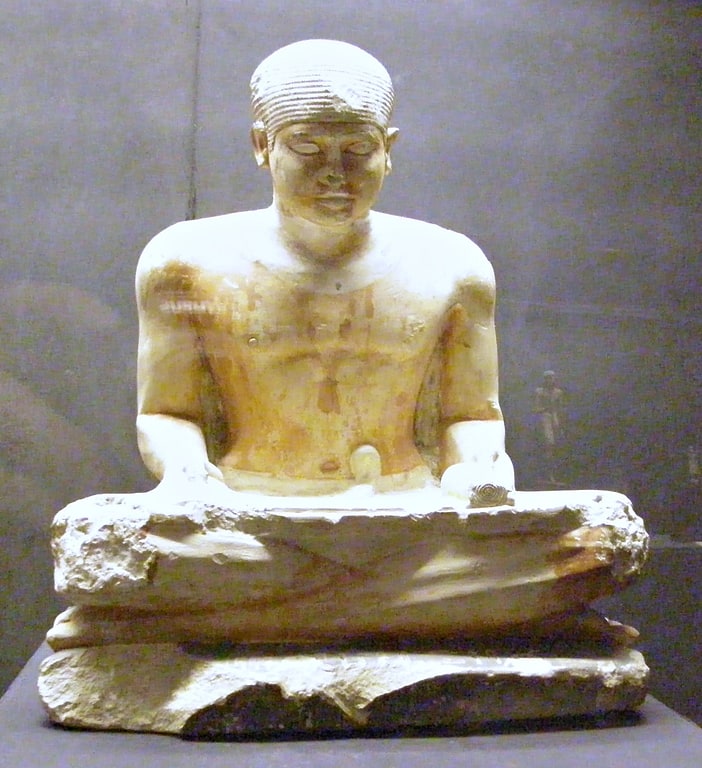
Museum in Egypt. The Imhotep Museum is an archaeological museum located at the foot of the Saqqara necropolis complex, near Memphis in Lower Egypt.[4]
Pyramid of Userkaf

Also known as: هرم أوسركاف
Pyramid in Egypt. The pyramid complex of Userkaf was built c. 2490 BC for the pharaoh Userkaf, founder of the 5th Dynasty of Egypt. It is located in the pyramid field at Saqqara, on the north-east of the step pyramid of Djoser. Constructed in dressed stone with a core of rubble, the pyramid is now ruined and resembles a conical hill in the sands of Saqqara. For this reason, it is known locally as El-Haram el-Maharbish, the "Heap of Stone", and was recognized as a royal pyramid by western archaeologists in the 19th century.
Userkaf's pyramid is part of a larger mortuary complex comprising a mortuary temple, an offering chapel and a cult pyramid as well as separate pyramid and mortuary temple for Userkaf's wife, queen Neferhetepes. Userkaf's mortuary temple and cult pyramid are today completely ruined and difficult to recognize. The pyramid of the queen is no more than a mound of rubble, with its funerary chamber exposed by stone robbers.
The complex is markedly different from those built during the 4th Dynasty (c. 2613–2494 BC) in its size, architecture and location, being at Saqqara rather than the Giza Plateau. As such, Userkaf's pyramid complex could be a manifestation of the profound changes in the ideology of kingship that took place between the 4th and 5th dynasties, changes that may have started during the reign of Userkaf's likely immediate predecessor, Shepseskaf. More than 1,200 years after its construction, the pyramid complex was restored under Ramses II. During the much later Saite period (664–525 BC), it was used as a cemetery.[5]
Pyramid of Teti
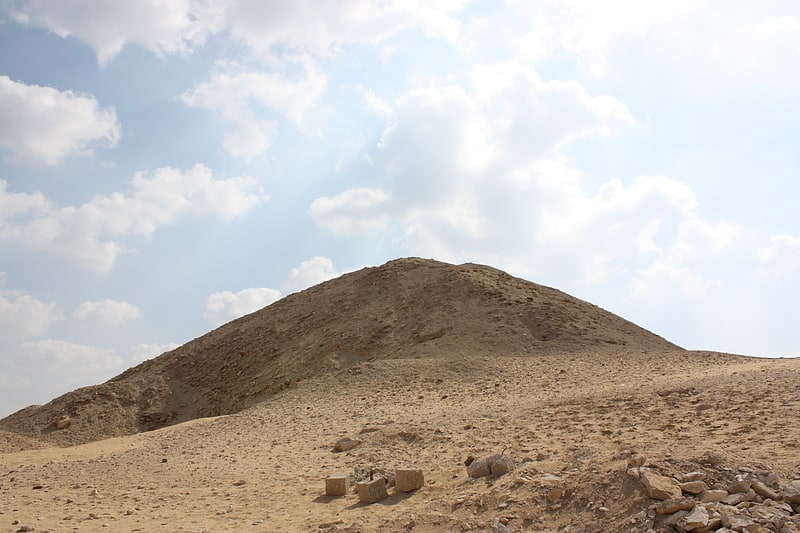
Also known as: هرم تتي
The Pyramid of Teti is a smooth-sided pyramid situated in the pyramid field at Saqqara in Egypt. It is the second known pyramid containing pyramid texts. Excavations have revealed a satellite pyramid, two pyramids of queens accompanied by cult structures, and a funerary temple. The pyramid was opened by Gaston Maspero in 1882 and the complex explored during several campaigns ranging from 1907 to 1965. It was originally called Teti's Places Are Enduring. The preservation above ground is very poor, and it now resembles a small hill. Below ground the chambers and corridors are very well preserved.[6]
Pyramid of Djedkare Isesi
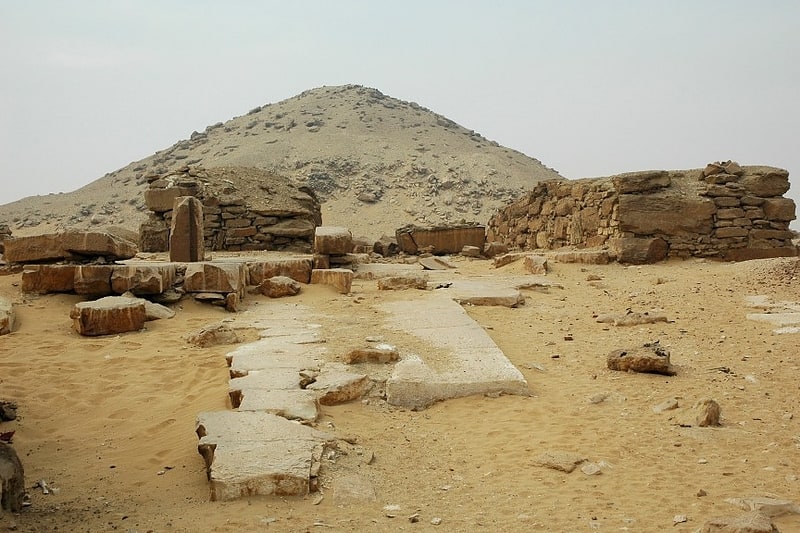
Historical landmark in Egypt. The Pyramid of Djedkare Isesi is a late 25th to mid 24th century BC pyramid complex built for the Fifth Dynasty pharaoh Djedkare Isesi. The pyramid is referred to as Haram el-Shawaf by locals. It was the first pyramid to be built in South Saqqara.
Djedkare Isesi's monument complex encompasses: a main pyramid; a mortuary temple situated on the east face of the main pyramid; a valley temple buried under modern Saqqara; a causeway that has been only partially dug out; and a cult pyramid. The main pyramid had a six-stepped core built from roughly cut limestone bound together by clay mortar which was then encased in fine white Tura limestone reaching a peak height of 52.5 m (172 ft; 100.2 cu). The casing has been plundered, and the top three steps of the core have been lost, leaving the pyramid a paltry 24 m (79 ft; 46 cu) tall. The basic dimensions of Djedkare's pyramid were adopted by succeeding kings in their own funerary monuments. Inside Djedkare Isesi's pyramid substructure, remains of the burial have been found alongside the mummy remains of Djedkare Isesi himself. The mummy and linen wrapping have undergone radiocarbon dating which have given a common range of 2886–2507 BC. The substructure has otherwise been badly damaged by stone thieves quarrying the Tura limestone casing.
Adjoining the pyramid's east face is the mortuary temple. Flanking the entrance hall to the temple are two large pylon structures. West of the south pylon, a large building with multiple long narrow rooms was discovered. The outline of the building has been preserved by foundational blocks, but its structure is otherwise poorly preserved, and its floor has been lost, possibly to stone thieves. The building has no contemporaries at other Old Kingdom pyramid complexes, and no companion on the north side. Its function is unknown. The mortuary temple was mostly destroyed during the Second Intermediate Period, and used as a burial site in the Eighteenth Dynasty. At the south-east corner of the pyramid, a small cult pyramid is found in an enclosure. It has a T-shaped substructure.
At the north-east corner of the pyramid complex's enclosure wall, a satellite pyramid complex belonging to Queen Setibhor was built. The sub-complex is the largest one built for a queen during the Old Kingdom. It has its own enclosure wall, a mortuary temple and offering hall, storage rooms, antichambre carrée of unparalleled size, a small cult pyramid, and otherwise incorporates features that were previously reserved exclusively for the complexes of the king.[7]
Pyramid of Merenre
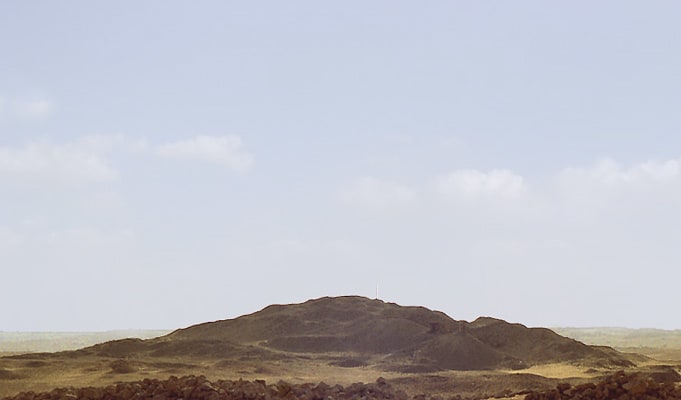
The pyramid of Pharaoh Merenre was constructed for Merenre Nemtyemsaf I during the Sixth Dynasty of Egypt at Saqqara 450 metres to the south-west of the pyramid of Pepi I and a similar distance to the pyramid of Djedkare. Its ancient name was "Merenre's beauty shines" or perhaps "The Perfection of Merenre Appears". Today it consists mostly of ruins; it is hard to get to and is not open to the public.
The pyramid was built 52.5 metres (172 ft 3 in) in height, 78.75 metres (258 ft 4 in) in base length with an inclination of 53°07'48". The causeway is 250 metres (820 ft) long and the complex was surrounded by a wall of mud brick.
Only traces of the mortuary temple have been found and the evidence indicates that construction was halted abruptly at one point and never resumed, probably upon the pharaoh's death.
The entrance to the burial chambers is on the north face which descends to a vestibule where another shaft leads to the antechamber. To the right of the antechamber is the burial chamber; to the left is another small room, a serdab. In the burial chamber a sarcophagus decorated with polychrome reliefs stood against the wall; when found, it was in good condition although it had been plundered. The ceiling of the burial chamber had an astrological theme and was covered with stars.[8]
Pyramid of Pepi II
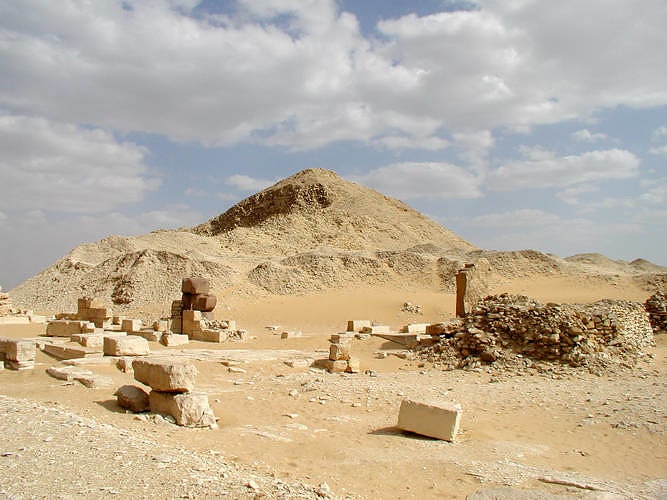
Historical landmark in Egypt. The Pyramid of Pepi II was the tomb of Pharaoh Pepi II, located in southern Saqqara, to the northwest of the Mastabat al-Fir’aun. It was the final full pyramid complex to be built in Ancient Egypt. Long used as a quarry, the pyramid was excavated for the first time by Gaston Maspero in 1881. Its ruins were studied in exhaustive detail by Gustave Jéquier, who was able to reconstruct the funerary complex and the texts on the walls of the funerary chamber in the course of his excavation campaigns from 1932-1935. Since 1996, thorough investigations of the pyramid and its surroundings have been being carried out by the Mission a.[9]
Statue of Ramesses II
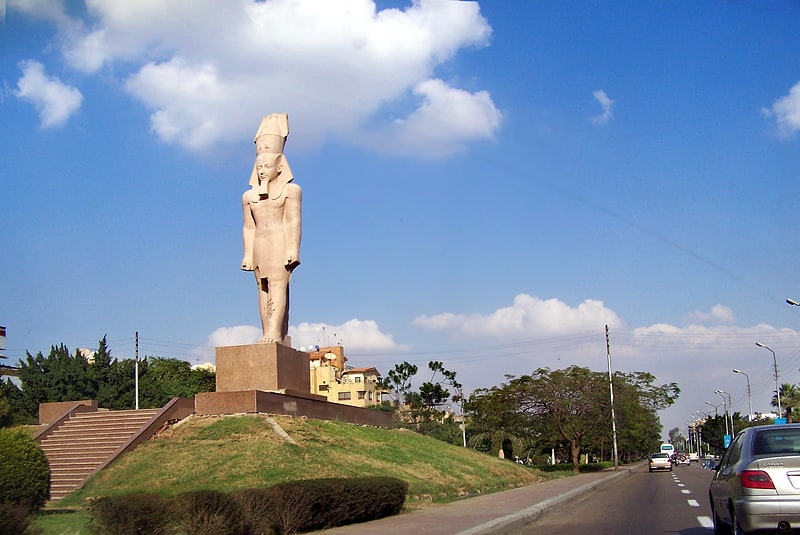
Also known as: تمثال رمسيس الثاني
The Statue of Ramesses II is a 3,200-year-old figure of Ramesses II, depicting him standing. It was discovered in 1820 by Giovanni Battista Caviglia at the Great Temple of Ptah near Memphis, Egypt. It is made from red granite and weighs 83 tons.
The statue was found broken in six pieces and earlier attempts at restoration failed. In 1955, Egyptian Prime Minister Gamal Abdel Nasser moved it to the large Bab Al-Hadid Square in Cairo, outside Cairo's main railway station; the square was then renamed Ramses Square. There the statue was restored to its full height of 11 meters and erected on a three-metre pedestal at the edge of a fountain. It was stabilized by iron bars inside the body.
Over time Ramses Square turned out to be an unsuitable location, as the statue was exposed to corrosive pollution and constant vibration from traffic and subways. The Egyptian government decided to relocate it to a more appropriate location in 2006. At a temporary site on the Giza Plateau it underwent restoration before being moved to the Grand Egyptian Museum (GEM) in Giza in 2018.
The transportation of the statue from Ramses Square to Giza was a technological challenge that had been in the planning since 2002. A replica had been made and was transported several weeks before the scheduled actual move along the planned route to Giza to test the proposed relocation process. The move took place on August 25, 2006. During its ten-hour transport the statue was wrapped and covered in rubber foam. Two flat-back trucks carried the weight of the statue and its support structures as it travelled in a vertical position.
The move has been criticized for its costs and the concern about pollution in the Giza location.[10]
Buried Pyramid

The Buried Pyramid is an unfinished step pyramid constructed c. 2645 BC for Sekhemkhet Djoserty. This pharaoh was the second of the Third Dynasty of Ancient Egypt, which reigned over Egypt circa 2686–2613 BC and is usually placed at the beginning of the Old Kingdom of Egypt. Many historians believe that the third dynasty played an important role in the transition from Early Dynastic Period of Egypt to the Age of the Pyramids.
The pyramid may be visited, but the public is not allowed access to the base and substructures.
Sekhemkhet Djoserty was also the successor to the better-known pharaoh Djoser, who was buried in his famous step pyramid at Saqqara. The buried pyramid was originally modelled after Djoser's step pyramid and is located several hundred metres southwest. It is also arguable that the pyramid of Sekhemkhet was originally designed to surpass the step pyramid of Djoser but barely made it above ground level and hence was given the name the Buried Pyramid. Its incompletion is thought to have been due to Sekhemkhet's short reign as ruler, which was approximately six years.[11]